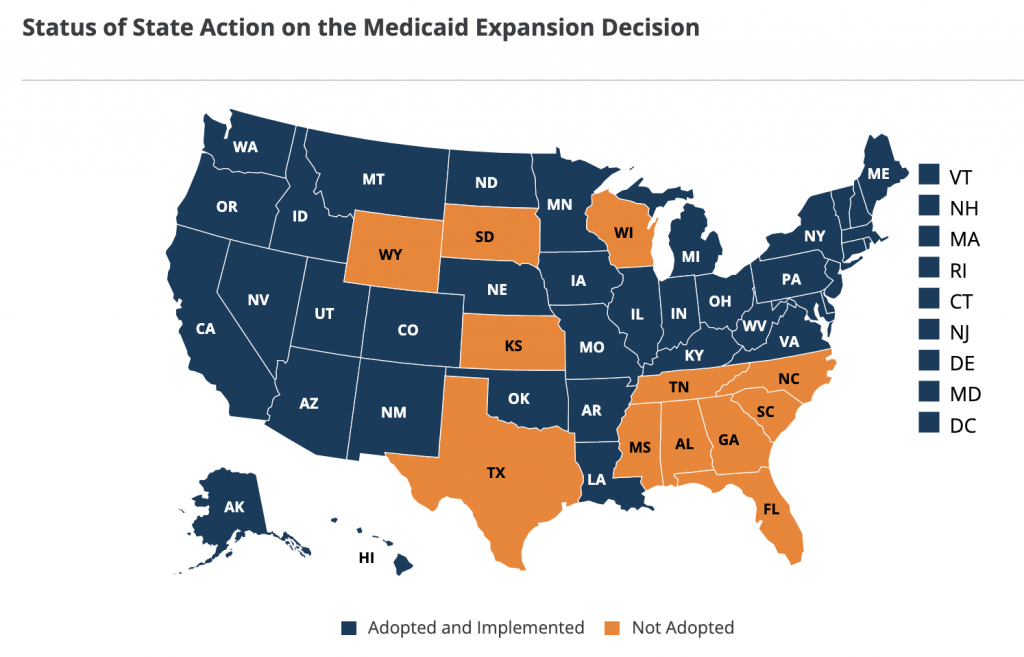The current Democratic child care proposal provides grants to states so that they can set up a complex system of child care subsidies for parents. States do not have to participate in the program and recent history suggests that many Republican-led states will choose not to participate. If that happens, then the children in those states will be effectively excluded from the child care program.
It is impossible to know in advance which states will participate in the program and which states will not. But we can make some educated guesses by looking at which states have opted not to participate in the ACA Medicaid expansion and which states opted out of participating in the pandemic Unemployment Insurance programs earlier this year.
There are currently 12 states that have refused to expand Medicaid under the parameters of the Affordable Care Act, which was passed over a decade ago. These states can be seen in orange in the graphic below.

It is reasonable to think that these same states would also choose not to participate in the Democrats’ child care system.
To see what effect this would have, I looked at what percent of children below the age of 3 live in these 12 states. Overall, 30.3 percent of young children live in these states and 43.5 percent of young black children live in these states.
According to the jargon of the moment, the design of this child care proposal is structurally racist because it heavily disproportionately excludes black and Latino children. The disproportionate racial exclusion is not because the design hurts lower class people who are disproportionately nonwhite, which is how these things usually go, but rather because the unique geography and politics of America are such that black people are heavily concentrated in former Confederate states, which are generally governed by very right-wing Republicans.
The exclusion of nearly 1 in 3 children from the program would be pretty bad, but the real number could end up being even higher than that.
There are currently 12 states that have not expanded Medicaid, but there were originally 24 states that refused to expand it. Political tides have changed a bit over the years, so it does not make sense to assume those exact same 24 states would initially opt out of the child care expansion. But to get a sense of what a similar lockstep Republican refusal to participate in the scheme would look like, we can see what percent of children live in the 26 Republican-led states that chose to opt out of the pandemic UI programs earlier this year.
As shown in the graph below, in this scenario, 44.6 percent of children end up not receiving any child care benefits, including 56.8 percent of black children.
Fake Fixes
When you raise this problem with proponents of the legislation, they’ll tell you that the bill fixes it by allowing localities in non-participating states to directly participate in the program and by allowing head start agencies in non-participating localities in non-participating states to receive grant money from the program.
But these measures don’t come anywhere close to solving the problem.
For starters, the amount of money being set aside for localities in non-participating states is only $1 billion per year. This is almost nothing and will be far below what is needed to cover all the kids in non-participating states even if you assume only a handful of states choose not to participate.
The amount of money being set aside for head start agencies in non-participating localities in non-participating states is only $3 billion per year. This also will come nowhere close to covering all the kids in non-participating areas. Furthermore, the $3 billion is not being given to head start agencies so that they can administer the kinds of child care subsidies called for in the rest of the bill. Rather, the money is being given to them so that they can “carry out the purposes of the Head Start Act in that area.”
Have the Federal Government Run the Program in Non-Participating Areas
The program designers are clearly aware of the problem of non-participating states, but instead of actually fixing that problem, they seem to have just set aside some trivial bits of money so that they have something to say when someone asks the question.
If you really wanted to solve this problem, what you would do is have the federal government directly administer the child care subsidy program in non-participating areas. This is how the ACA health insurance exchanges are designed: participating states run their own exchanges while the federal government runs exchanges in non-participating states. There is no reason why the administration of the child care subsidy program could not also be done this way.
If the Democrats pass the legislation in its current form and then Republican states refuse to participate, Democrats will spend the next decade or so talking about how mean and evil the Republicans are for blocking child care subsidies for so many Americans. But Democrats have the ability right now to make it so that it doesn’t matter if state-level Republicans refuse to participate in the program. Democrats are instead choosing a design that gives state-level Republicans veto power over this legislation. When the predictable results of that choice materialize, the Democrats will have only themselves to blame.

